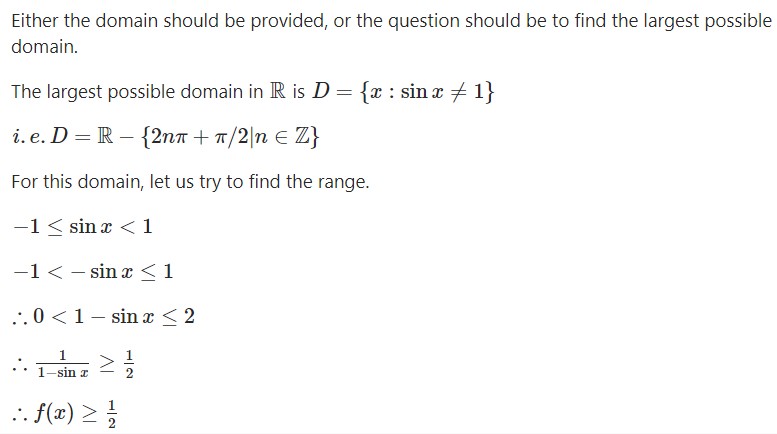Analyzing the Domain and Range of the Function $f(x) = \frac{1}{1 - \sin x}$
What is the domain and range of the function $f$ defined by $f(x)=\frac{1}{1-\sin x}$?
In my book the solution is the following:
But I have some questions:
1. The domain if $f$ is $\mathbb{R}$-$D$. The elements of $\mathbb{R}$ are real numbers, but the elements of the set $D$ are angles in radians. How is possible the domain is difference of two different sets? (If we want to find the largest domain, we can consider;for example, the set $A$ (whose elements are all the angles in radians) instead of $\mathbb{R}$, this makes more sense!).
2. For its range, I know it is using the following fact: $-1\leq \sin x\leq1$ $\forall x\in \mathbb{R}$. The above I know is true when $x$ is radians or degree. But how is possible that is right for real number? Actually, my question is the following: How to define senx and cosx for x real number in such a way that they continue to fulfill the known properties when x is radian o degree?
- accepted
- 1431 views
- $20.00
Related Questions
- I need help on this problem! it's trigonometric functions I believe. If you could show your work that would be even better! Thank you guys
- Work problem involving pumping water from tank
- Derivative of FUNCTION
- Prove that $\lim_{n\rightarrow \infty} \int_{[0,1]^n}\frac{|x|}{\sqrt{n}}=\frac{1}{\sqrt{3}}$
- Urgency Can you help me Check these Applications of deritive.
- real analysis
- Evaluate $\int ...\int_{R_n}dV_n(x_1^2 + x_2^2 + ... + x_n^2)$ , where $n$ and $R_n$ is defined in the body of this question.
- Find the coordinates of the point $(1,1,1)$ in Spherical coordinates

